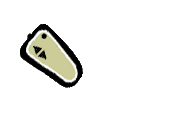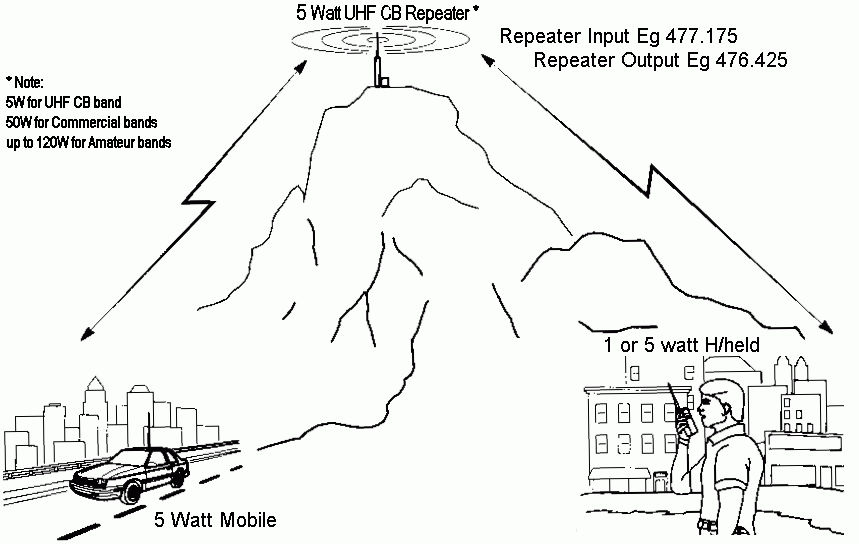Repeaters
A repeater is used on the VHF and higher bands to help increase the distance units can communicate. At these frequencies signals are limited to "line of sight" and as repeaters are generally located on mountain ranges or on top of tall buildings, the increase in physical height provides an increase in the "line of sight" and therefore a significant increase in the distance units can communicate. Sometimes the repeaters will also transmit at a higher power than available to the mobile or hand-held units, but it is the height advantage that provides the majority of increased communication range. Repeaters use two different frequencies (or channels), receiving a signal on one frequency (known as the repeater input or base receive), and then simultaneously re-transmitting the signal on the second frequency (known as the repeater output or base transmit). The radio units using the repeater automatically change frequency between transmit and receive. To listen to all transmissions on a repeater you need to tune to the repeater output or base transmit frequency (also called mobile receive).
CTCSS
Long ago and not so far away, Motorola came up with a way to get more than one Land Mobile customer on the same frequency at almost the same time. They figured that different customers could coexist on the same frequency if they did not have to listen to each other routinely. They invented Continuous Tone Coded Squelch System or CTCSS for short and patented it as PL short for Private line. Other manufacturers, finding that the system was absolutely necessary to stay competitive came up with Channel Guard, Quiet Channel, Call Guard, and many other names for the same thing to avoid lawsuits for marketing a patented system.
The manufacturers of amateur equipment seem to have settled on tone for encode only and tone squelch for encode/decode. Most of the amateur VHF and UHF equipment manufactured in the last ten years has at least encode capability (standard or optional) and many have decode capability (standard or optional).
When it is available, it is simply a plug in circuit board. Aftermarket encoders and encoder/decoders can be added to virtually any transceiver since they have now been developed smaller than a postage stamp.
The system is based on a subaudible tone injected after the audio stages into the transmitter during encode and the tone is detected before the audio circuits in the receiver. The decoder switch is then used to perform some function, usually to unmute the receiver when the tone is decoded.
In the commercial equipment, the audio bandwidth tends to be narrower than our amateur equipment and there are circuits installed to filter out the tones so they are truly subaudible. Most of our amateur equipment transmits and receives a much broader audio bandwidth and has no special tone filters, so most hear the tones. The lower the tone frequency the less audible it tends to be.
Meat and Potatoes of CTCSS
The system is designed around a set of relatively low frequency tones (32 or 38 depending on which standard you use) ranging from 67.0 Hz to 250.3 Hz. The tones are a perfect sine wave and the frequency tolerance is very tight, typically +/- 0.5 Hz. The tone is encoded and injected into the transmitter after the audio shaping circuits. The frequency deviation (level) is typically 0.4 to 0.8 kHz which is rather insignificant when compared to the typical 5 kHz voice deviation.
In the receiver, the tone is detected right off the discriminator before any audio processing and decoded allowing the receiver to unmute. Commercial radios filter out the tone, but our amateur radios do not so the tone is usually noticeable. It is sometimes mistaken for a power supply hum.
CTCSS does not alleviate RF interference. If two FM signals are on the same frequency at the same time, there will still be a heterodyne or beat note (unless one is 6 dB stronger than the other). But if CTCSS is being utilized and both systems use different CTCSS tones, they will not have to listen to the other systems traffic.
With the advent of commercial repeater stations, several customers can use the same repeater without listening to each others transmissions. In a commercial installation, the microphone hanger is grounded and when the mic is hung up, the decoder is turned on, thus muting the receiver. When the operator picks up the mic, the decoder is disabled and the receiver becomes carrier squelch, hearing everything within range. If nothing is heard, the call is made. If another user is heard, they are supposed to monitor until the traffic clears and then make their call. Base station mics have a monitor button next to the PTT button to disable the decoder, allowing the operator to check for traffic.
Amateur radios do not have this automatic feature since the CTCSS system is used to allow users to restrict what they want to listen to, not to allow several fleets of radios to operate on the same frequency. Most handheld radios that can be factory equipped for full CTCSS encode and decode have a monitor button, usually around the PTT bar. Unfortunately, amateur mobiles have to manually turn off the tone to monitor the channel in the carrier squelch mode.
The Electronic Industries Association (EIA) and Bell Labs designed the tones used so that none were a harmonic of any other, to keep the encode and decode circuits simpler. Motorola later added their own two letter designators to the tones for their own system, but the frequencies are the same.
This system has since been superseded in state of the art by Digital Coded Squelch or DCS, but is still largely the state of the practice for many commercial and amateur radio systems
The standard Electronic Industries Association (EIA) frequency codes, in hertz, with their Motorola alphanumeric designators are as follows:
|
67.0 - XZ |
97.4 - ZB |
141.3 - 4A |
206.5 - 8Z |
|
69.3 - WZ |
100.0 - 1Z |
146.2 - 4B |
210.7 - M2 |
|
71.9 - XA |
103.5 - 1A |
151.4 - 5Z |
218.1 - M3 |
|
74.4 - WA |
107.2 - 1B |
156.7 - 5A |
225.7 - M4 |
|
77.0 - XB |
110.9 - 2Z |
162.2 - 5B |
229.1 - 9Z |
|
79.7 - WB |
114.8 - 2A |
167.9 - 6Z |
233.6 - M5 |
|
82.5 - YZ |
118.8 - 2B |
173.8 - 6A |
241.8 - M6 |
|
85.4 - YA |
123.0 - 3Z |
179.9 - 6B |
250.3 - M7 |
|
88.5 - YB |
127.3 - 3A |
186.2 - 7Z |
254.1 - 0Z |
|
91.5 - ZZ |
131.8 - 3B |
192.8 - 7A |
|
|
94.8 - ZA |
136.5 - 4Z |
203.5 - M1 |
|


